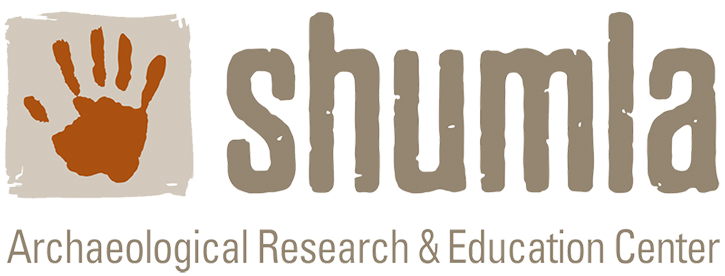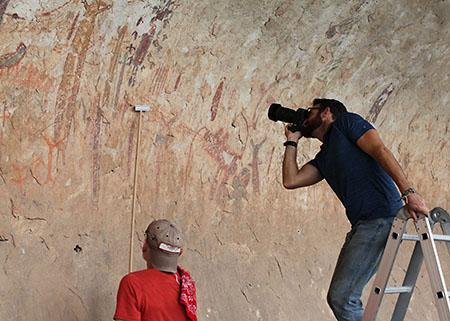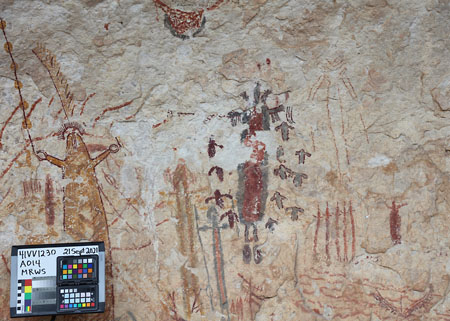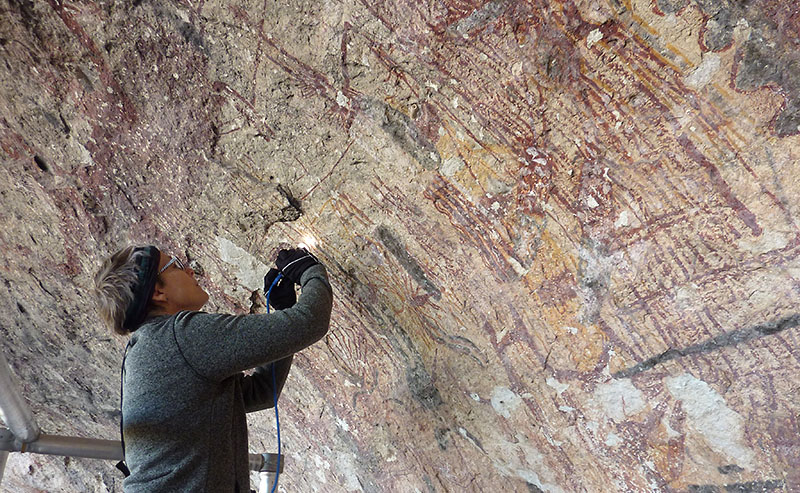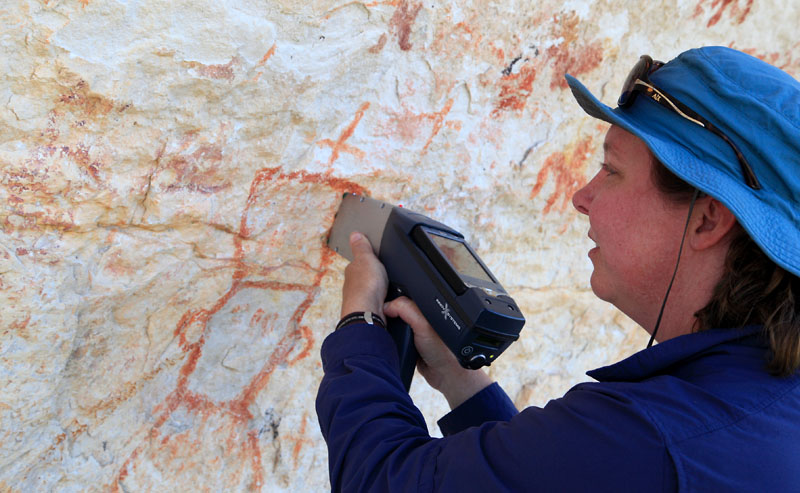The Shumla Method
Shumla has developed an intensive scientific method for the documentation of rock art called
“The Shumla Method of Rock Art Documentation.”
Level 1 — Baseline Documentation
- Site Forms: A State of Texas Archaeological Site Form (TexSite) is completed. This form records general information such as site type, names of recorders, work performed, location, etc. It is augmented by Shumla’s Rock Art Site Form, which documents information such as number of panels and their orientation, level of preservation, and a general description of the rock art.
- Mapping: We record the exact location of each mural with a Spectra Precision Mobile Mapper 120 data collector and a handheld Garmin GPSMAP 64st. This provides an extremely accurate, differentially corrected GNSS/GPS centroid coordinate for the site.
- Mural Photography: We create a high-resolution Gigapan panoramic image of the mural. This image serves as a feature map during Level 2 documentation.
- Structure from Motion Photogrammetry Image Capture: We capture the image data needed for the 3-D modeling process described below.
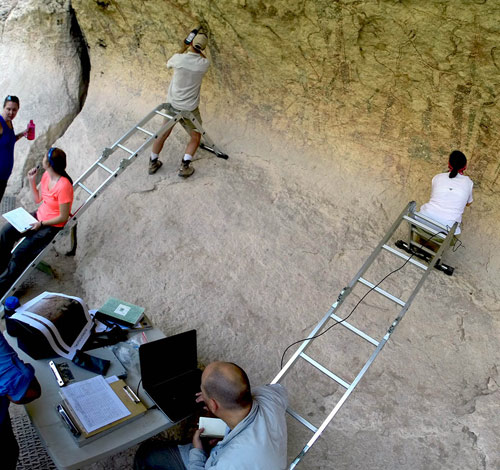
 Dr. James Keyser
Dr. James Keyser
Retired U.S. Forest Service Archaeologist and author of multiple rock art books
Level 2 — Figure Documentation and Analyses
- 3-D Modeling: We create a digital 3-D model of the rockshelter and mural using Structure from Motion (SfM) Photogrammetry. SfM modeling is done using a hand held camera (Canon 5Dsr), to produce 3-D models that rival 3-D LiDAR Scanning in accuracy for only a fraction of the cost. For some sites, we use a Leica LiDAR laser scanner to create our 3-D model with sub-centimeter accuracy to capture the detailed morphology of the shelter. 3-D models allow for the digital or physical replication of a mural and rockshelter. This is especially important if a site is in imminent danger of being destroyed. Site replicas can also be used to reduce visitation to actual sites, such as is done at some of the European Palaeolithic cave sites.
- Figure Identification and Description: Each figure in the mural is assigned a unique identification code. The figure’s location in the mural is shot into a local XYZ coordinate system with a Total Data Station (TDS). This is georeferenced into a universal coordinate system using a highly accurate, static GPS system. This level of documentation allows us to examine spatial relationships between and among figures.
- Figure Photography: Figure photography includes three types of photographic documentation:
- Standard Figure Photography: Overall, midrange, close-up and detail photographs are captured for each figure. (Up to 50 photographs for a large figure). Photographs are taken with a calibrated light meter and grey scale to ensure proper exposure and white balance, as well as a color checker passport for automated color calibration.
- Multifocal Stacking Image Capture: A series of between 5 and 50 photographs are taken from the same position but at differing focus. These photos are then “stacked” by the software to produce an image in perfect focus with an extended depth of field.
- Microscopic Photography: We use a Dino-Lite Digital Microscope to capture microscopic photographs used to determine the painting sequence of multi-colored figures, the relationship of associated figures, and ultimately the painting sequence for an entire mural. Results of this analysis are entered into Harris Matrix Composer software to graphically diagram mural stratigraphy.
- Chemical Analyses: The types of chemical analyses conducted at a site can range from non-destructive, such as portable X-ray fluorescence spectroscopy (pXRF) to examine the elemental composition of the paint, to destructive, such as removing 1 to 1.5 cm paint samples for radiocarbon dating to determine the age of the mural.
Level 3 — Graphic Database Production:
The Graphic Database is a “living” document produced within Adobe Photoshop. For each figure, the graphic database provides a foundation of contextual data from past, current, and future documentation efforts in the same visual workspace. A graphic database includes some or all of the information listed below:
- Figure Photographs: The color calibrated close-up figure photograph, as well as color enhanced versions of the close-up photograph.
- Figure Illustrations: Layered, digital illustrations of each figure produced in Photoshop on a Wacom Cintiq interactive pen display. Each color layer is ordered based on the results of the microscopic analysis, as well as additional field observations.
- Figure Attribute Data: Figure identification codes and descriptions are entered into Shumla’s searchable rock art database along with more than 150 pieces of attribute data for each figure. Attributes include information that can be classified, measured and counted such as physical characteristics, paraphernalia, and body adornments. Database query analysis reveals patterns that can be used to begin the process of interpretation.
- Digital Microscopy: The exact locations analyzed using digital microscopy, as well as the results of that analysis.
- pXRF: The exact locations analyzed using pXRF, as well as the results of that analysis.
- Radiocarbon sample(s): The exact locations from which samples were collected, as well as the radiocarbon date of each sample.
What happens to all that data?
When your method of preservation is the collection of data — the maintenance of that data far into the future is of utmost importance. It is no preservation at all, if the collected data is lost or not accessible.
Shumla is committed to maintaining the security, accessibility, and integrity of the data we collect. We have developed rigorous procedures for the long-term management and storage of our vast data sets. The many terabytes of data generated by this project are archived in a sophisticated database in an intuitive and user-friendly organizational structure and in file formats that will be accessible into the future. Shumla utilizes three separate servers. To protect us from hardware failure, our servers incorporate variations of redundant arrays of independent disks, or RAID systems. These systems provide protection from drive failures through disk mirroring and offer a performance boost by dividing all data among multiple disks, thus splitting the workload. RAID can help minimize data loss, but ultimately backups are required to protect collected data. Shumla backs up data on a daily, weekly, and monthly basis. Daily backups are stored on the server itself, but weekly and monthly backups are stored on an offsite server away from headquarters.
Data generated is made available to a broader audience through site reports, publications in peer-reviewed journals, books, master’s theses, exhibits, public presentations, and professional conferences to increase awareness, and promote research and preservation of the region’s exceptional cultural resources.

